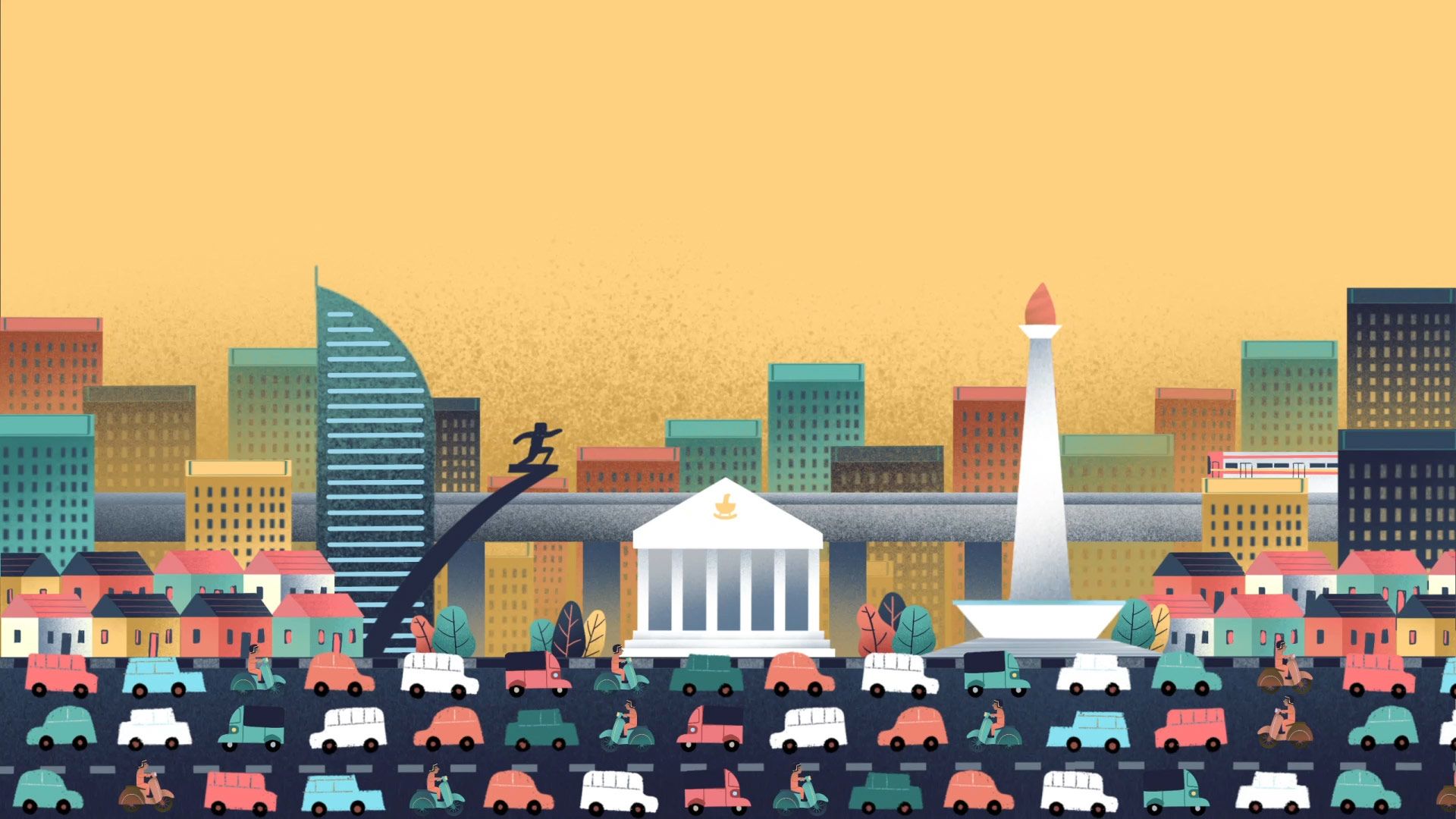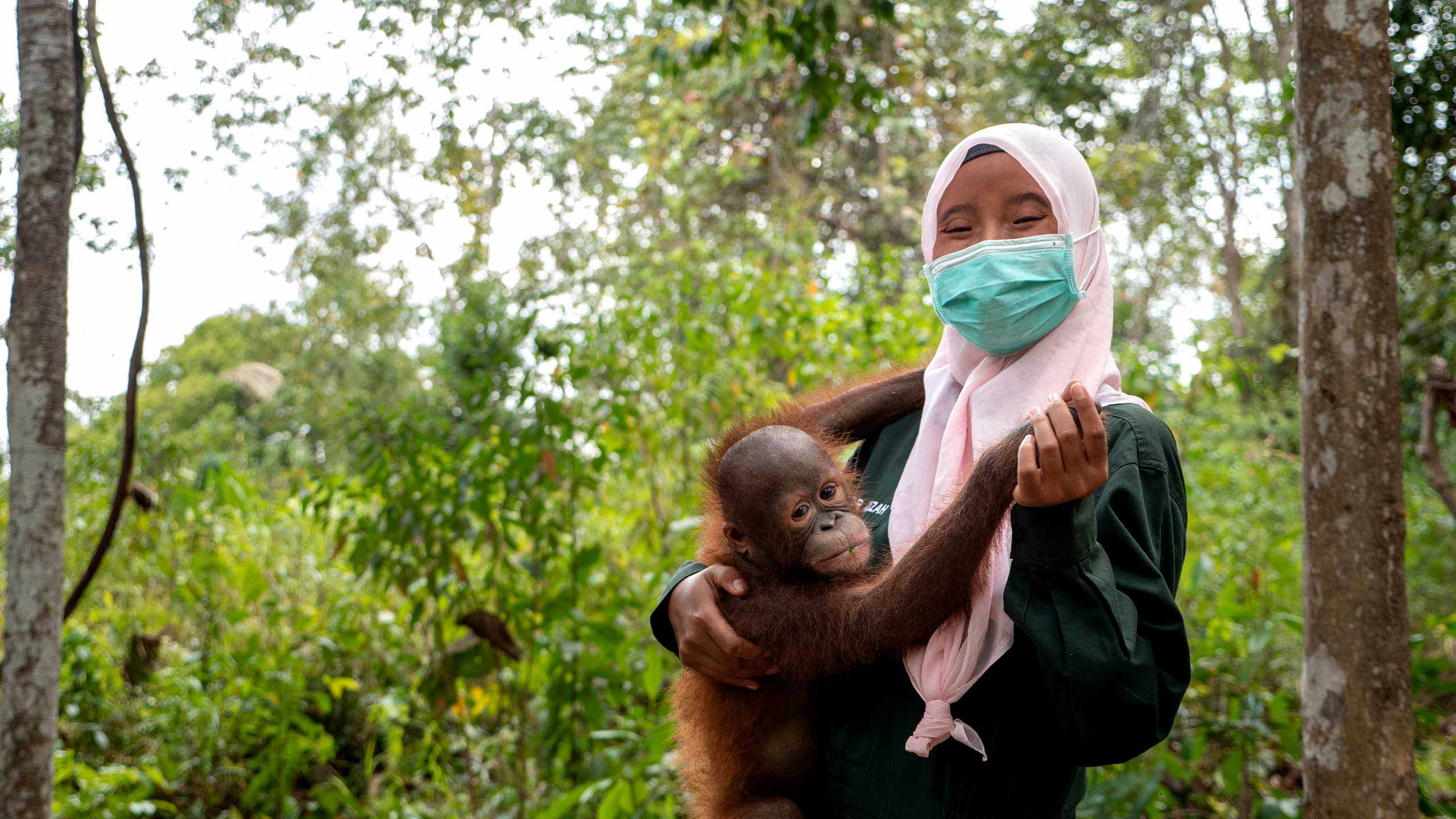When your capital is sinking...
Start again?

Winda’s house in the Indonesian city of Jakarta is sinking 20cm (8 inches) every year. She has paid for four truckloads of rocks, gravel and cement to build up the foundations. That keeps the rising sea levels from her door, but there is an unfortunate side effect.
“The ceiling is getting closer and closer with each layer we put on,” she exclaims. It is now within touching distance - just 50cm (20 inches) above her head.
Jakarta’s story is a cautionary tale for city planners. Vulnerable to climate change - the Java Sea is rising - but also sinking, literally, under the weight of bad governance and a host of poor decisions.

An abandoned mosque in Jakarta
For Winda this means continuing to raise her foundations.
“Where else can we go? We don’t have the option of moving,” she says.
But the Indonesian government does have that option - and is taking it. It has announced it is moving its administration about 2,000km (1242 miles) to a site in the Indonesian province of East Kalimantan on the island of Borneo.

The US$34bn design is for a compact coastal city with five satellite towns, built on restored oil palm plantations and surrounded by wetlands and tropical forests. The aim is to complete the initial phase of construction by 2025.
The choice of location makes sense politically and economically - Borneo is much closer to the centre of Indonesia’s sprawling archipelago.
But the island is also home to some of the world’s most important forests, and is teeming with wildlife. It is one of the most biodiverse places on the planet.
The Indonesian leadership promises it will be a sustainable city the like of which Indonesia, and arguably the world, has never seen. Environmentalists fear however that this ambitious plan could have disastrous implications.
The architectural team which won the government-run competition to design the capital - Urban+ architects, based in Jakarta - say its aim is to work with nature, not against it.
“We want to create a city
in balance with nature.”

“We do have this incredible opportunity to start again – to build from nothing,” says Sofian Sibarani, the head of Urban+.
“We have a chance to design something much closer to an ideal city than anything we have now.”
He says the plan is that 70% of the 2500 sq km (965 sq mile) area allotted for the new city will be green space, and that the built areas will include an institute which will specialise in reforestation, and a botanical garden.
He adds that the idea is to make it a compact walkable city, with areas that are pedestrian-only, and that the additional transport that is needed will be electric.
The five satellite towns which surround the city will be separated by green belts so they don’t leach into each other, he says, explaining that they want to learn lessons from Jakarta, whose own satellite towns have merged, resulting in out-of-control urban sprawl.
Jakarta’s other major planning issue is the fact that due to a lack of access to piped tap water, most people rely on pumping out groundwater, which is causing the land surface to sink. The crisis is compounded by rising sea levels as a result of climate change. If nothing is done, it is predicted that by 2050 95% of Jakarta’s coastal area will be under the sea.
Sibarani says the issue with Jakarta, and other cities like it, is that they are no longer in balance with nature. So his team has chosen what is known as a biomimcry approach - learning from our surroundings. In the case of Urban+’s design, it means taking inspiration from the four distinct layers of the rainforest.
Rita Padawangi, an Indonesian urban planning expert at the Singapore University of Social Sciences, says that as an exercise in urban design, it “hits all the right buttons”.
“If you think what a new city should have, it taps into the digital revolution with all the high-tech elements and it’s trying to be sustainable,” she says.
But she is deeply worried about the impact of the plan to move the capital to Borneo.
“When you look at it from a social and environmental perspective I still have lots of questions. Like it or not, if you are going to build a city there will be a footprint - conversion of land that is greenery, or unbuilt land into built land - and that will have an impact.”
An environmental impact assessment of the project has yet to be carried out.
Padawangi’s other key concern is whether the design will be faithfully implemented.
“It looks good on paper but as we all know Indonesia doesn’t have a very good track record in this regard,” she says.
Despite government promises that it will be a green city, the state electricity company says the promised renewable energy will be primarily hydropower.
Three hydroelectric power plants are planned for East Kalimantan. They come with their own environmental problems and fall well short of the energy needed for the new capital.
That has left activists worried that the bulk will have to come from coal-fired power plants. At least three coal plants are already planned for construction in the province.
Indonesia is the top exporter of thermal coal, and the province where the new capital will sit is the nexus of that boom.

The government has issued at least 1,434 mining permits in East Kalimantan, spanning more than 50,000 sq km (19,305 sq miles) - an area larger than Belgium.
Kardi moved his family to East Kalimantan in the 1970s - as part of a major government-sponsored transmigration programme to get people off the overcrowded island of Java and into more sparsely populated areas of Indonesia.
“Lots of people didn’t last,” he laughs. “It was too tough so they went home. There were lots of wild pigs and monkeys - they stole our food.”
He has witnessed incredible change here but has also paid a high personal cost for the development that East Kalimantan has already seen.
According to Jatam, an Indonesian mining advocacy network, East Kalimantan has 1,735 inactive open pit mines that belong to 1,404 companies which have failed to honour their legal obligation to fill in exhausted pits and restore the land.
It is just one example of how the area has already been exploited at the expense of the local community.
Kardi’s 10-year-old granddaughter Natasya Aprilia Dewi was playing near one such abandoned coal mining pit - now full of rainwater - last May, when she fell in and drowned.
“She couldn’t swim and the sharp sides of the pit meant she didn’t have a chance of climbing out.”
Natasya's mother, Purwanti, says she could only believe her daughter died when she saw her body.
“I was so shocked… she was such a good girl. I hoped that she could have grown up and fulfilled her dreams. She would have made us proud. She wanted to become a doctor.”

Natasya in a photo held up by her mother
Natasya is one of 36 people who have died in abandoned mining pits in East Kalimantan in the last eight years - most of them children.
Kardi hopes that if the central government is closer – not hundreds of miles away on another island – their concerns will be listened to rather than ignored.
And he is also excited about the financial potential of the capital moving to Borneo.
“It’s growth, it’s the future, and as a result this area will become busier and it will improve the economic situation here, so there will be more jobs.”
But indigenous people in the area
are not so enthusiastic.

Dahlia, from the Paser tribe, says she is worried the move could destroy her community’s unique culture.
“We are disappointed and scared. We are worried that our land will be filled with tall buildings and we will lose our way of life,” says the 23-year-old.

Dahlia leads a dance troupe in Sepaku village, close to where the capital will be
She is also worried about the further migration it will bring.
“We have to prepare ourselves to protect our culture, our language, and hope people will not steal our land,” she says.
She has never been to the current capital, but she has seen it on television and is not impressed. “I don’t want to live under bridges like the poor do in Jakarta.”
Indigenous people like Dahlia have already had to witness other changes on Borneo. In the last 50 years, tens of millions of hectares of forest has been cleared - one of the fastest deforestation rates in the world - to make way for the coal mines, but also to accommodate pulp and paper and oil palm plantations.
Indonesia is now the world’s largest producer of palm oil - a product used in everything from shampoo to chocolate.
Syukran Amin, also from the Paser tribe, says that the community is already in conflict with the concessions running the palm oil and pulp and paper plantations, and believes the plan to move the capital will just mean they have to fight the government as well.
“We know their ‘forest city’ plans but we don’t want them to plant trees - we want them to protect the forest that is left here," he says.
“We were once known as the lungs of the world, we don’t want our forest replaced with city plants.”

For those who will move here from Jakarta, however, the prospect appears to be an exciting one - at least for the younger people on an official tour to the area.
Diaz Diandra, one of the one million civil servants who will have to relocate, is enthusiastic, despite the long gruelling journey on speedboat and bone-jangling buses to get here from Jakarta.
“I am thrilled and excited about living in a city that has been planned and has good public transport,” the 30-something says while visiting the area on an official tour.
“I can leave behind all the long hours stuck in traffic getting to work.”
Leading the tour is Minister Bambang Brodjonegoro who was at the helm of this project at its outset. He stands on a tower overlooking the site - a seemingly endless stretch of oil palm trees.
He reiterates that the government will honour its promise to look after forest that falls within the 2500 sq km (965 sq miles) designated for the new capital.
“We know conservation forest in this area has been degraded and used for other illegal purposes but now we will protect it.”
He also pledges that the government will restore the dangerous abandoned coal mines and will start a process of granting land certificates to the indigenous community in order to guard against land grabs.
But there is little trust among environmentalists here.
Dedi Irawan, a local environmentalist who works with mining advocacy group Jatam, takes us into Bukit Suharto – 619 sq km (239 sq miles) of thick jungle which is one of the last big areas of virgin forest left in East Kalimantan and which sits within the area earmarked for the new capital.
Under the canopy of thick trees
he predicts this forest
will be vulnerable to development

“They say they will protect this… but we have had promises before. We have seen mining companies come in with promises that they would restore the land and that didn’t happen,” he says.
A collaboration of rights and environmental groups released a report earlier this year which found that a number of the concessions granted previously in the area are linked to some of the country’s wealthiest and most powerful business figures and politicians.
With the permits for some of these concessions not set to expire for another 20 years, there are concerns over how and at what cost the government can force the holders to relinquish them. The government insists there is no legal requirement to compensate concession holders for relinquishing the land.

Dedi does not trust the government's promises
There is also disquiet over the make-up of the advisory board for the capital - it is chaired by Crown Prince Sheikh Mohammed bin Zayed Al Nahyan of the United Arab Emirates and includes such figures as Masayoshi Son, the billionaire founder and chief executive of Japanese holding company SoftBank, and former UK Prime Minister Tony Blair.
Planning specialist Rita Padawangi says this deepens her fears about who the new capital is really being built for.
“Why can’t the indigenous people be the advisors? They are the ones who are going to be most affected by this.
“Is it just going to be a gated community of elite civil servants coming from Jakarta?” she asks.
Development in Borneo has implications not just for the local people, but for the wildlife too.

Davi heads off to forest school at 09:00. He is one of the orphaned orangutans at a sanctuary and rehabilitation centre run by the Borneo Orangutan Survival Foundation that falls within the outer ring of the new capital area.
Orangutans are a protected species in Indonesia, but the rapid deforestation means they are now critically endangered. For those that have been orphaned, staff at the foundation try to fulfil the role that their mothers would have played and teach them survival skills.
“We feed them, teach them how to find food and when they are old enough we show them how to climb trees,” says Isna, an employee at the centre, as she carries Davi on her back.
Today they are learning how to make a nest up a tree. Davi, as the youngest, needs a little help climbing the tree. And then everyone works together to make a safe place to sleep.
Once the orangutans have learned these vital skills the hope is they can be returned to the wild.

But it is getting harder to find suitable forest to return them to as a result of deforestation - often the forests are burned to make way for the plantations.
In 2015, out-of-control fires burned approximately 26,000 sq km (10,039 sq miles) across Indonesia - an area roughly the size of Rwanda. They destroyed 3 sq km (1.2 sq miles) of the precious forest at the orangutan sanctuary.
Researchers from Harvard and Columbia Universities linked the toxic haze that year to more than 100,000 premature deaths. And the amount of carbon emissions released in a few months was equal to the emissions in the US over a year.
Despite promises from the government that the disaster would not happen again, last year fires once again blanketed the region in haze.

A firefighter walks through last year's Borneo smog
Jamartin Sihite, the CEO of the Borneo Orangutan Survival Foundation, hopes that if the country’s leadership are in Borneo, things might change.
“When the politicians come close to nature and develop great feelings for the natural landscape then it will be easier,” he says.
“They will know that there is no forest for the orangutans. They will see it and have to face it directly. I don’t have to go to Jakarta to try and explain.”
But he warns that without meticulous planning and public participation, the new capital city could suffer from the same fate as Jakarta.
“If they repeat the mistakes made in Jakarta it will just move the problem. They’re coming to Borneo, they have to use the forest as a key part of the development, or not come to Borneo at all.”

It’s a sentiment Sofian Sibarani, the winning designer, strongly agrees with.
Over the coming months his team will be working on making the urban design guidelines for the new capital.
“Hopefully this time they will be enforced because this time the world will be watching,” he says.
Listen to the podcast here and watch the TV documentary here
Credits
Writer: Rebecca Henschke and Abraham Utama
Illustrations: Davies Surya
Graphics: Arvin Supriyadi and Aghnia Adzkia
Photos: Haryo Wirawan, Yudistira Tribudiman, Rory Moon, Getty images
Data sources: Centre for International Forestry Research, World Resource Institute, Global Forest Watch
Editor: Sarah Buckley
Publication date: 5 March 2020